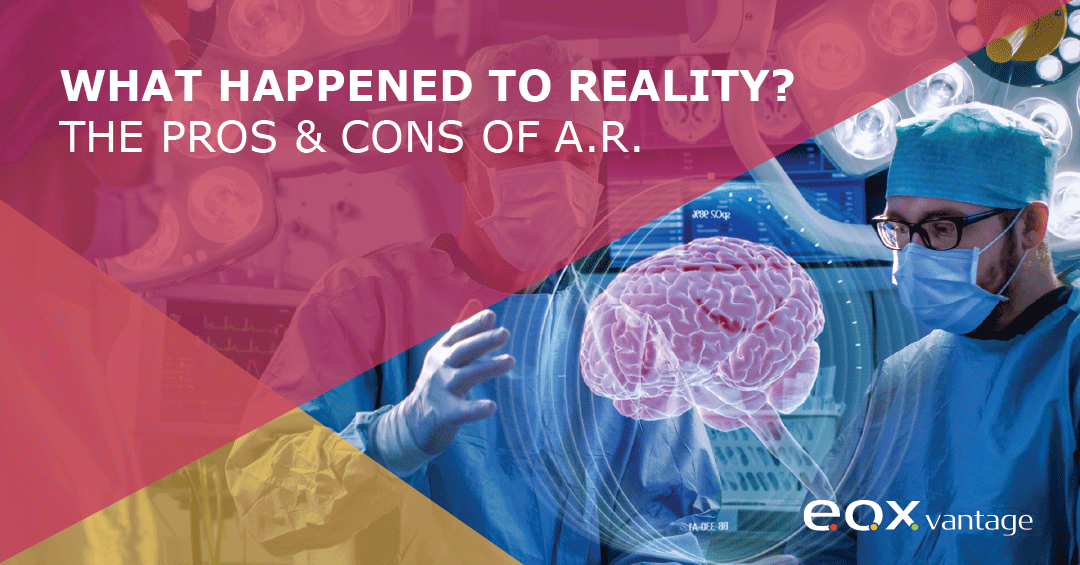
Augmented reality, virtual reality…what happened to our reality? As we progress through the digital age, technology is rapidly becoming ingrained into every part of our lives. Is this for better or for worse? While these advancements are seemingly fascinating, is there a point where the technology we are using can become invasive or even dangerous? In this Tech Tuesday, we are going to take you on a journey through the captivating technology that is Augmented Reality (AR); the pros and cons, benefits and dangers. We will leave it up to you to decide if reality as we know it is dwindling or enhancing to new heights.
With the advent of technologies like AR, VR, AI -the list goes on and on- our world is quickly changing, but what is it exactly, and what can it provide? Like virtual reality, AR provides an altered experience through 3D, high definition sound and video. It’s a way to integrate digital images and sounds right into a user’s real surroundings. Sounds pretty cool, right? Actually, you may have used AR before, and perhaps didn’t even know it. Remember the game “Pokémon Go”? AR was used to make all the Pokémon creatures appear right on screen. AR is an immersive experience as it combines the digital and real world, allowing for a user experience unlike any other.
The Benefits:
Combining the physical and digital world makes for new advancements right at our fingertips. Take the medical field for example; they have taken advantage of “medical AR” which will allow surgeons to have a “heads-up” display of a patient’s electronic medical records (EMR). This ultimately leads to more engaging 1-on-1, doctor-to-patient discussion, and less time searching through files. In surgery, AR can improve accuracy by providing detailed images of veins and organs so surgeons can improve the precision of their incisions, and decrease errors.
Besides surgeries, AR is enhancing the way people interact and perceive information. AR headsets, like Microsoft’s HoloLens, allow users to visualize digital images through a lens, creating an all too seemingly real experience. With the headset, users can look around, walk through and expand digital objects. Take a student studying anatomy for example; he or she can place the headset on and view a life-like image of the human body. The student is able to walk around it, examine it, zoom in to see veins, arteries, muscles and tissues. It allows an enhanced learning experience. Students studying space can put the headset on and take a walk around the solar system. How else could you take a 5-second trip around the sun?
AR is also becoming practical for the business world, by giving end-users an improved experience by adding value to the buying process. For example, clothing stores will begin to have “virtual fitting rooms” where customers can superimpose clothing onto themselves to see how it looks. In fact, Ikea has already done this. Customers can superimpose furniture into their homes to ensure it fits and looks exactly the way they want. Now, that’s one creative way to enhance the buying process!
Are you a product or services company? Don’t worry, there’s room for AR in your operations too! Add value to your product or service by allowing AR to take the wheel and give users a 360-degree, augmented view of your product or service, so they can see first-hand exactly what they’re purchasing. Providing visibility into your operations is one of the top ways to enhance the user experience -we at EOX Vantage know that first-hand with our innovative Enterprise Operating System.
Doesn’t all this technology sound impressive? It is, however there are still a few potential downsides, as with most technologies.
The Downsides:
When you’re superimposing digital realities into actual realities, potential physical injuries are prone to happen. We saw it with Pokémon Go. People became too engulfed in their virtual reality, and unaware of the dangers surrounding them; cars, other bystanders, buildings, walls, etc. Are we all going to be walking around with our faces glued to our phones? With the introduction of AR, are we losing the sense of real communication? The simple answer is yes, but we were already on this trajectory…this is only adding fuel to the fire.
Privacy concerns may also halt the mass adoption of AR. The devices that use the technology require data, and lots of it. It’s not only on the user of the device, but also the environment and surrounding people that are viewed through the device. This raises major privacy concerns, and brings up the question of when is enough, enough. When will we begin living in the moment again, rather than through a screen?

What’s your consensus? Like all technologies, AR has the power to become life-altering; some may say for better, and others may say for worse. Imagine all the ways that AR could improve our lives, making businesses run smoother, processes easier and learning enhanced. On the other hand, it can become an invasion of privacy, cause serious injuries, and in some ways, make us a less connected as a society. In what ways do you think technology is impacting our lives? We’ll leave that up to you to decide.


